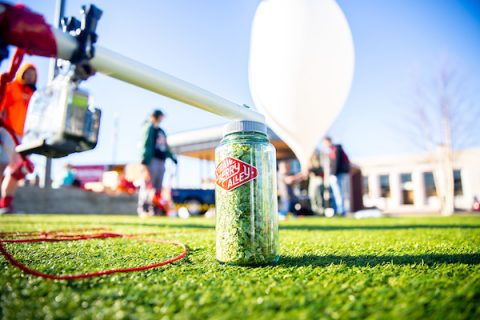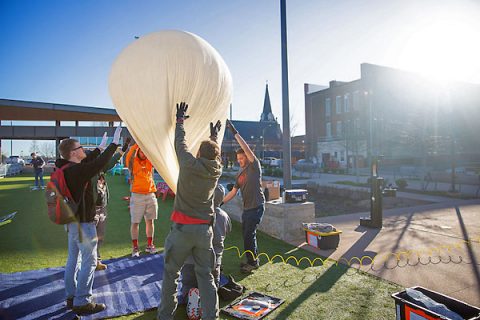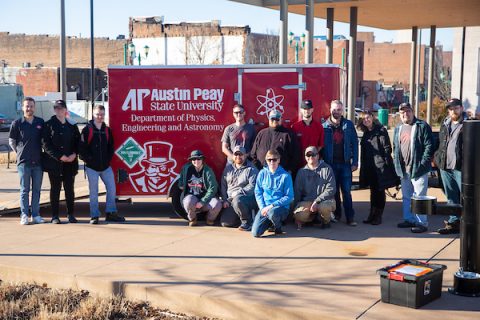 Clarksville, TN – In the waning light of a January afternoon, a group of Austin Peay State University (APSU) physics students pushed through branches and saplings as they hiked up a steep hill outside of Carthage, Tennessee.
Clarksville, TN – In the waning light of a January afternoon, a group of Austin Peay State University (APSU) physics students pushed through branches and saplings as they hiked up a steep hill outside of Carthage, Tennessee.
The team of young researchers was looking for a high-altitude weather balloon they’d launched 93,000 feet into the stratosphere earlier that day.

A tracking device, attached to the balloon, led them more than 100 miles from campus into that dark canopy of trees, and when they finally found the payload and its parachute, a hopeless “what do we do now?” expression caused their teeth to clinch.
“It was a rough hike, really steep, and we found it about 60 feet up in a tree,” Bryan Gaither, Austin Peay State University physics, astronomy and engineering lab manager, said. “It was going to be a long day.”
Gaither clipped on his tree-climbing gear and slowly made his way toward the stranded payload. To the west, the sun sank deeper behind the hillside, casing the mild winter air to drop several degrees.
“We were fighting daylight hard and my hands were cramping,” Gaither said. “I got all the way up to as high as my gear would let me go, and then I pulled up this 16-foot pole saw, and for an hour and a half I worked at it.”
The marooned payload carried important scientific data the team wanted to recover, but Gaither also hoped to retrieve the two special containers he’d attached to the balloon that morning. Inside were beer hops that had traveled high into that hazy region known as near space.
“I want some hoppy beer out of this,” he said.
High-altitude beer

Earlier that day, Wes Cunningham with Strawberry Alley Ale Works stood in Clarksville’s Downtown Commons park, watching the APSU physics students inflate a large, two-kilogram weather balloon. A loud hiss accompanied the process, causing a few morning commuters to pause and look suspiciously at Cunningham and the others.
“This was Bryan’s crazy idea to send up a balloon with some beer hops,” Cunningham said. “He’s going to send up some hops to near space, and once it comes back down, we’re going to brew a special batch of beer with it.”
“It’s great when you can find ways to tie the university and the community together,” Dr. Karen Meisch, dean of the APSU College of STEM, said.
Strawberry Alley will host a tapping party for the special beer later this spring.
Actual Science

Last June, APSU physics student Zach Hill, along with fellow student Zach Givens, attended Rocket Week at NASA’s Wallops Flight Facility in Virginia, where he helped send Austin Peay’s first payload into space.
Seven months later, on that chilly but clear January morning in Downtown Commons, Hill made a final check of his equipment before sending it into the stratosphere. Launching beer hops 96,000 feet into the air makes for a fun story around the bar, but Hill’s work – the main reason for that day’s balloon launch – may put APSU one step closer to one day having an actual satellite in space.
For the project, he used a wireless technology called ZigBee to test the ability for different payload boxes to send data to each other during a flight.
If the ZigBee works better than Bluetooth technology, then the department will look at sending up two balloons to see if they can communicate with each other. From there, it’s just a short leap to recording data from an Austin Peay State University satellite.
Once Hill finished checking the payloads, he stepped away so Gaither, wearing a Strawberry Alley T-Shirt, could release the balloon into the air.
“Do we have tracking data?” Gaither shouted. The students checked their phones, confirming that they would be able to track the balloon.
After a brief countdown, Gaither released the balloon, which quickly rose into the air. The Austin Peay State University physics team packed up their gear and headed off in pursuit of the balloon. On the way to one of the trucks, someone said they hoped it would land in an open field, making for an easy day’s work.



